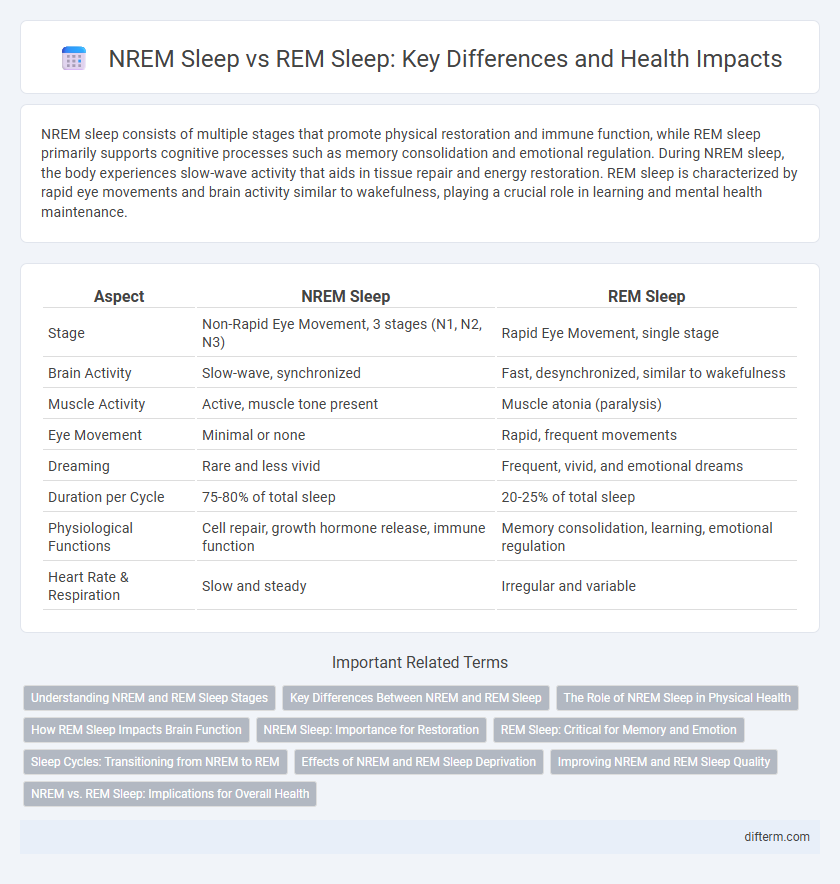NREM sleep consists of multiple stages that promote physical restoration and immune function, while REM sleep primarily supports cognitive processes such as memory consolidation and emotional regulation. During NREM sleep, the body experiences slow-wave activity that aids in tissue repair and energy restoration. REM sleep is characterized by rapid eye movements and brain activity similar to wakefulness, playing a crucial role in learning and mental health maintenance.
Table of Comparison
| Aspect | NREM Sleep | REM Sleep |
|---|---|---|
| Stage | Non-Rapid Eye Movement, 3 stages (N1, N2, N3) | Rapid Eye Movement, single stage |
| Brain Activity | Slow-wave, synchronized | Fast, desynchronized, similar to wakefulness |
| Muscle Activity | Active, muscle tone present | Muscle atonia (paralysis) |
| Eye Movement | Minimal or none | Rapid, frequent movements |
| Dreaming | Rare and less vivid | Frequent, vivid, and emotional dreams |
| Duration per Cycle | 75-80% of total sleep | 20-25% of total sleep |
| Physiological Functions | Cell repair, growth hormone release, immune function | Memory consolidation, learning, emotional regulation |
| Heart Rate & Respiration | Slow and steady | Irregular and variable |
Understanding NREM and REM Sleep Stages
NREM sleep consists of three stages characterized by slow brain waves, reduced heart rate, and body temperature drop, primarily facilitating physical restoration and memory consolidation. REM sleep features rapid eye movements, increased brain activity, and muscle atonia, playing a crucial role in emotional regulation and cognitive functions like dreaming. Understanding these distinct sleep stages helps optimize sleep hygiene and supports overall health by balancing physical recovery and mental processing.
Key Differences Between NREM and REM Sleep
NREM sleep consists of three stages characterized by slower brain waves, reduced physiological activity, and bodily restoration, while REM sleep features rapid eye movement, vivid dreaming, and heightened brain activity similar to wakefulness. NREM primarily supports physical recovery and immune function, whereas REM sleep is essential for memory consolidation and emotional regulation. Brain wave patterns in NREM show delta and theta waves, contrasting with the mixed frequency and sawtooth waves typical of REM sleep.
The Role of NREM Sleep in Physical Health
NREM sleep plays a crucial role in physical health by supporting tissue repair, muscle growth, and immune system function through the release of growth hormone predominantly during deep sleep stages. It facilitates metabolic regulation, contributing to energy restoration and cardiovascular health by lowering blood pressure and heart rate. Adequate NREM sleep is essential for maintaining overall physical well-being and optimizing recovery processes.
How REM Sleep Impacts Brain Function
REM sleep enhances brain function by promoting neural plasticity and memory consolidation, vital for learning and emotional regulation. During REM sleep, increased activity in the hippocampus and prefrontal cortex supports the integration of new information and problem-solving abilities. This sleep stage also facilitates the clearance of metabolic waste, reducing the risk of neurodegenerative diseases.
NREM Sleep: Importance for Restoration
NREM sleep plays a critical role in physical restoration by promoting tissue repair, muscle growth, and immune system strengthening, which are essential for overall health recovery. During NREM stages, the brain decreases metabolic activity, allowing for energy conservation and synaptic homeostasis, crucial for cognitive function and memory consolidation. Research highlights that deep NREM sleep (slow-wave sleep) is particularly important for hormone regulation, including the release of growth hormone, which supports cellular repair processes.
REM Sleep: Critical for Memory and Emotion
REM sleep plays a crucial role in memory consolidation and emotional regulation by allowing the brain to process and integrate information from the day. During REM sleep, increased neural activity supports the strengthening of synaptic connections essential for learning and emotional resilience. This sleep stage also facilitates the processing of emotional experiences, reducing stress and enhancing mood stability.
Sleep Cycles: Transitioning from NREM to REM
Sleep cycles alternate between NREM (Non-Rapid Eye Movement) and REM (Rapid Eye Movement) phases, with each cycle lasting approximately 90 minutes. During the transition from NREM to REM sleep, the brain shifts from slow-wave activity to more rapid and desynchronized patterns, facilitating memory consolidation and emotional processing. This cyclical pattern is crucial for restoring cognitive function and maintaining overall health.
Effects of NREM and REM Sleep Deprivation
NREM sleep deprivation impairs physical recovery, leading to muscle soreness, weakened immune function, and cognitive deficits such as poor memory consolidation. REM sleep deprivation primarily affects emotional regulation, causing increased anxiety, mood swings, and diminished ability to process complex information. Both types of sleep loss contribute to overall health deterioration, emphasizing the critical balance between NREM and REM sleep for optimal functioning.
Improving NREM and REM Sleep Quality
Improving NREM and REM sleep quality enhances cognitive function, memory consolidation, and physical recovery by optimizing deep and dream sleep phases. Techniques such as maintaining a consistent sleep schedule, creating a dark, cool sleeping environment, and reducing exposure to blue light before bedtime significantly enhance the duration and efficacy of NREM and REM cycles. Nutrient-rich diets, stress management practices, and regular exercise further support the natural regulation of sleep architecture, promoting restorative NREM stages and vivid REM sleep for overall health benefits.
NREM vs. REM Sleep: Implications for Overall Health
NREM sleep, characterized by slow-wave brain activity, plays a crucial role in physical restoration, immune function, and memory consolidation, while REM sleep primarily supports emotional regulation, cognitive processing, and brain development. Imbalances between NREM and REM sleep stages can lead to impaired immune response, increased risk of cardiovascular diseases, and cognitive deficits. Ensuring adequate proportions of both NREM and REM sleep is essential for optimal overall health and mental well-being.
NREM sleep vs REM sleep Infographic

 difterm.com
difterm.com